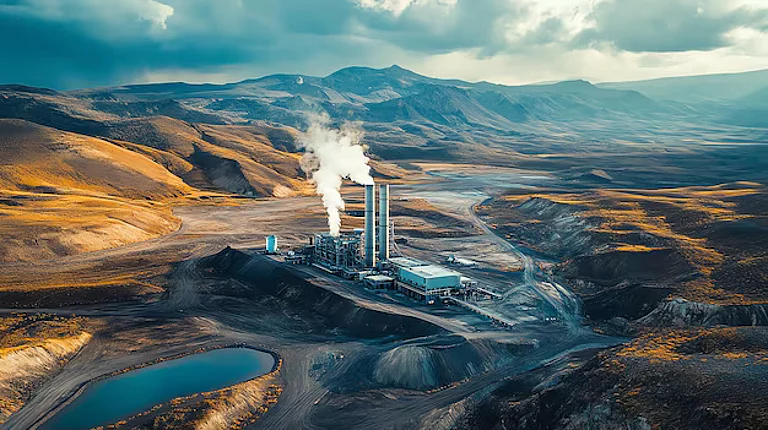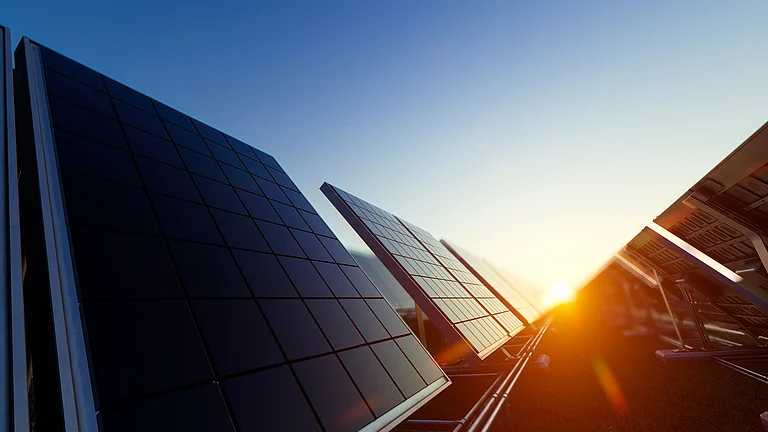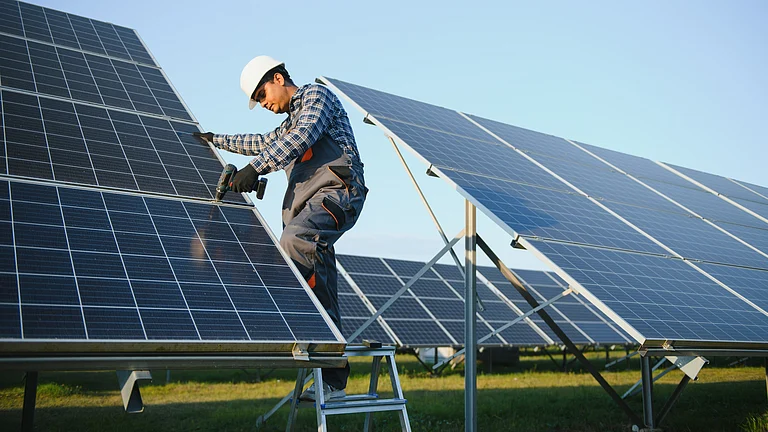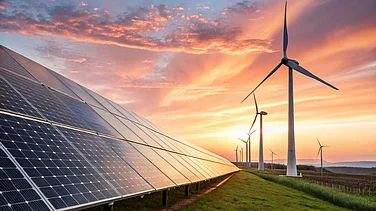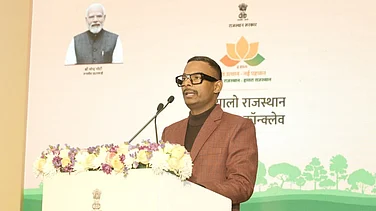
MNRE Secretary Santosh Kumar Sarangi stressed legacy through reforms and institution-building, not just capacity addition.
He dismissed rollback concerns, citing progress in green hydrogen tenders and record-low ammonia prices.
The government favours a phased, market-driven hydrogen rollout over mandatory obligations.
Key focus areas include grid upgrades, battery storage, and regulatory reforms to boost clean energy adoption.
As Secretary of the Ministry of New and Renewable Energy (MNRE), Santosh Kumar Sarangi is steering India’s ambitious clean energy agenda at a time when global interest in green hydrogen, solar, and storage is rising—and so are the challenges. In this interview, he rebuts concerns about policy rollbacks, highlights India's record-low green ammonia prices, and confirms that long-term offtake contracts are gaining traction both domestically and abroad.
Sarangi defends the government’s cautious stance on mandatory hydrogen purchase obligations, emphasising a phased, market-building approach. He also outlines how grid expansion, battery storage incentives, and regulatory reforms are being deployed to ensure renewable energy replaces thermal, not merely supplements it. On legacy, he’s clear: capacity is important, but transforming systems, building trust-based markets, and creating resilient institutions is what will define success.
The green hydrogen mission began with bold declarations and MoUs. But recent rollbacks—such as Assam’s aborted policy—have prompted investor unease. What’s being done to restore momentum?
There is no rollback of any kind that would create unease among Indian developers. The activities under the National Green Hydrogen Mission have accelerated over the past year, with many new sectors aiming for hydrogen adoption. As you are aware, a few buses and trucks have already commenced trials for the use of hydrogen in the transport sector. In addition, steel sector technologies for use of hydrogen are at the design stage to set up plants. Many small-scale green hydrogen plants have started production. A total capacity of over 3,000 tonnes per year currently exists, and these capacities are steadily increasing.
However, the major action recently has been the much-awaited refinery and fertiliser tenders under the mission. As you know, IOCL was the first to finalise the purchase of green hydrogen for the next 25 years at a very competitive price. HPCL and BPCL have also concluded their tenders thereafter.
Last week, a significant milestone was achieved under NGHM, with price discovery completed by SECI for the first-ever procurement of green ammonia—75,000 metric tonnes per annum (MTPA)—for Paradip Phosphates Ltd. This resulted in a record-low price discovery of ₹55.75/kg, highlighting the growing momentum in the emerging green hydrogen market. A similar process will be carried out by SECI in August for the remaining 12 projects, totalling about 6,50,000 TPA.
This price equates to approximately USD 641 per metric tonne (MT), which is a notable reduction from the USD 1,153/MT price discovered in the earlier H2Global auction. The 10-year fixed-price contract offers a compelling economic case for off-takers to begin or accelerate their transition to clean energy.
Additionally, international offtake tenders such as HintCo in Europe and Japan’s Contracts for Difference (CfD) scheme are emerging as potential export opportunities for Indian suppliers. These developments are accelerating momentum in India’s green hydrogen market through global demand and long-term export contracts. The allocation of financial incentives under the mission for 8,62,000 TPA of green hydrogen production, coupled with favourable policies, will provide distinct advantage to Indian companies in fulfilling the mission targets by 2030.
Although there has been some delay by developed countries in adopting green hydrogen as a feasible option for decarbonising hard-to-abate sectors, the situation is improving. We can expect many agreements by Indian green hydrogen producers with overseas purchasers.
Unlike solar and wind, green hydrogen lacks demand-side policy support like RPOs. What’s holding back the rollout of similar obligations or incentives to create assured offtake?
Under the National Green Hydrogen Mission, a demand of 7,24,000 TPA (tonnes per annum) of green ammonia has been identified, intended for supply to 13 fertiliser units, making it the largest green ammonia tender globally. Additionally, 2,00,000 TPA of green hydrogen production capacity has been earmarked to cater to requirements in the refinery sector. This approach effectively serves as a demand-side policy support mechanism, akin to Renewable Purchase Obligations (RPOs), aimed at ensuring sustained market development and adoption.
Adopting a mandatory approach through purchase obligations (HPO) would not be a prudent step at early stage, considering the evolving nature of the green hydrogen value chain. In the initial projects, technology assessment and economic viability need to be stabilised to offer a mature ecosystem that can provide confidence to suppliers as well as the purchasers to implement such obligations. Therefore, the government’s approach of identifying selected entities for demand creation, such as fertiliser units and refineries, would result in more effective stimulation for promoting green hydrogen adoption.
In addition, a few international programmes such as MBM (Market-Based Measures) by the IMO (International Maritime Organisation) and CORSIA (Carbon Offsetting and Reduction Scheme for International Aviation) by ICAO (International Civil Aviation Organisation) will create global demand for green hydrogen derivatives. Indian companies will get a good opportunity to leverage these initiatives for securing international offtakes.
With thermal power generating over 70% of electricity despite being less than half of installed capacity, how is the government addressing this imbalance to enable a smoother low-carbon transition?
The Indian government is actively working to increase the share of non-fossil-based electricity in the national grid. The installation of more than 50% non-fossil capacity is significant in the overall power generation capacity mix, as investor confidence is growing for non-fossil projects despite their intermittent nature. With electricity demand expected to grow at a rate of 8–10% over the next two decades, the non-fossil share of electricity will continue to rise and is expected to exceed 50% during the next decade. The need for thermal-based electricity will remain essential to meet demand during non-renewable energy (non-RE) hours. This can effectively address the imbalance between thermal power generation and installed renewable capacity through a multi-pronged strategy aimed at accelerating the low-carbon energy transition.
Grid stability is key to reducing thermal generation and meeting renewable targets. How is the government addressing this critical need?
To address the critical need for grid stability amid rising renewable energy integration and to reduce reliance on thermal generation, the Indian government is implementing several strategic initiatives:
a. Massive Grid Expansion
India plans to invest in grid infrastructure by 2030 to support its 500 GW renewable energy target.
This includes expanding transmission lines, substations, and smart grid technologies to handle variable solar and wind energy inputs.
b. Battery Energy Storage Systems (BESS)
A Viability Gap Funding (VGF) scheme worth ₹5,400 crore supports 30 GWh of BESS capacity to store excess renewable energy and stabilise supply. BESS helps manage peak demand and reduces curtailment of clean energy.
c. Strengthening Interstate Transmission System (ISTS) and InSTS
ISTS enables seamless power flow across states, reducing congestion and curtailment. The intra-state system supports state-level transmission needs. The Green Energy Corridor (GEC) schemes—Phases I & II—have contributed to these projects through central assistance.
d. Regulatory & Market Reforms
The government is promoting open access, green energy corridors, and corporate Power Purchase Agreements (PPAs) to attract private investment and improve grid flexibility.
Efforts are also underway to improve the financial health of DISCOMs (distribution companies).
e. Geographic Balancing
Renewable-rich states like Rajasthan and Gujarat are being connected to high-demand regions like Delhi-NCR and Maharashtra to balance supply and demand efficiently.
The Ministry of Power has already issued mandatory guidelines in February 2025 requiring energy storage integration in solar tenders. All renewable energy implementing agencies and state utilities must incorporate a minimum of two-hour co-located energy storage systems (ESS), equivalent to 10% of the installed solar project capacity, in future solar tenders.
India targets 500 GW non-fossil capacity by 2030, but FGD relaxations and coal investments raise concerns—how do these align with climate goals?
India's ambitious target of achieving 500 GW of non-fossil fuel capacity by 2030 is a significant step towards a sustainable energy future and aligns with its climate goals. However, the recent relaxations in Flue Gas Desulfurization (FGD) norms and continued investments in coal raise valid concerns regarding the coherence of these actions with the overarching objective of reducing carbon emissions and combating climate change.
Alignment with Climate Goals
Transition Strategy: The 500 GW non-fossil capacity target reflects India's commitment to transitioning towards cleaner energy sources. This includes a diverse mix of solar, wind, hydro, and biomass energy—essential for reducing reliance on fossil fuels and lowering greenhouse gas emissions.
Short-term vs. Long-term Goals: While investments in coal and the relaxation of FGD norms may seem contradictory to climate goals, they can be viewed as part of a transitional strategy. Coal remains a significant part of India's energy mix, and ensuring that existing coal plants operate more efficiently and with lower emissions can help bridge the gap while renewable capacity scales up.
Policy Framework: The government’s commitment to renewable energy is supported by various policies and initiatives promoting clean energy investments, including financial incentives, regulatory support, and international collaborations that enhance the viability of non-fossil fuel projects.
While solar capacity continues to expand, wind has failed to keep pace despite ample potential. What structural bottlenecks—policy, land, transmission—are stalling the sector? And can they realistically be resolved within this decade?
As of 30.06.2025, the installed wind energy capacity in the country is 51.67 GW. The expansion of solar capacity has outpaced wind in recent years. One major reason is the reluctance of power purchasers to procure wind energy at higher tariffs, which is primarily due to the higher capital cost of wind power projects. Additionally, developers have shown a shift in interest toward solar projects due to Right of Way (RoW) issues encountered by wind developers.
Further, during land acquisition, project developers face various challenges such as uncertainty in land ownership, and conflicts or protests by local residents during execution.
Transmission infrastructure development is also a major requirement for the rapidly growing RE capacity in the country. The target of 500 GW of non-fossil fuel-based power generation by 2030 includes 340 GW of ground-mounted solar and wind. This comprises 110 GW connected to the Intra-State Transmission System (InSTS) and 230 GW to the Inter-State Transmission System (ISTS). As of 30 April 2025, ISTS connectivity for about 338 GW has been granted or is under process for various RE developers.
You assumed office at a time when MNRE’s mandate had expanded—from megawatts to markets, diplomacy, and decarbonisation. What are your priorities for the remainder of your term?
As I assumed office during a pivotal time for the Ministry of New and Renewable Energy (MNRE), I recognise the enhanced mandate that encompasses not only the deployment of renewable energy megawatts but also broader aspects of market development, energy security, economic growth, and decarbonisation of sectors. My priorities for the remainder of my term will focus on accelerating renewable energy deployment, promoting technological innovation, strengthening market mechanisms, creating green jobs, boosting domestic manufacturing, and bringing more investments into the RE sector through continuous stakeholder engagement.
Looking ahead, what would you wish your legacy to be? Not merely in capacity added, but in the systems reformed, markets shaped, and institutions strengthened.
I aspire for my legacy to be defined by transformative policy reforms in the renewable energy sector that extend beyond mere capacity additions. I envision a reformed regulatory framework that fosters agility and transparency, a dynamic market characterised by fair competition and equitable access, along with strengthened institutions that enhance collaboration and capacity in clean energy adoption. My goal is to promote inclusive stakeholder engagement, ensuring diverse voices are heard while advancing our climate goals on the global stage. Ultimately, I wish to leave behind a resilient and sustainable clean energy ecosystem that not only meets current needs but also supports sustained economic growth and creates opportunities for future generations—paving the way for a prosperous and equitable energy future.









